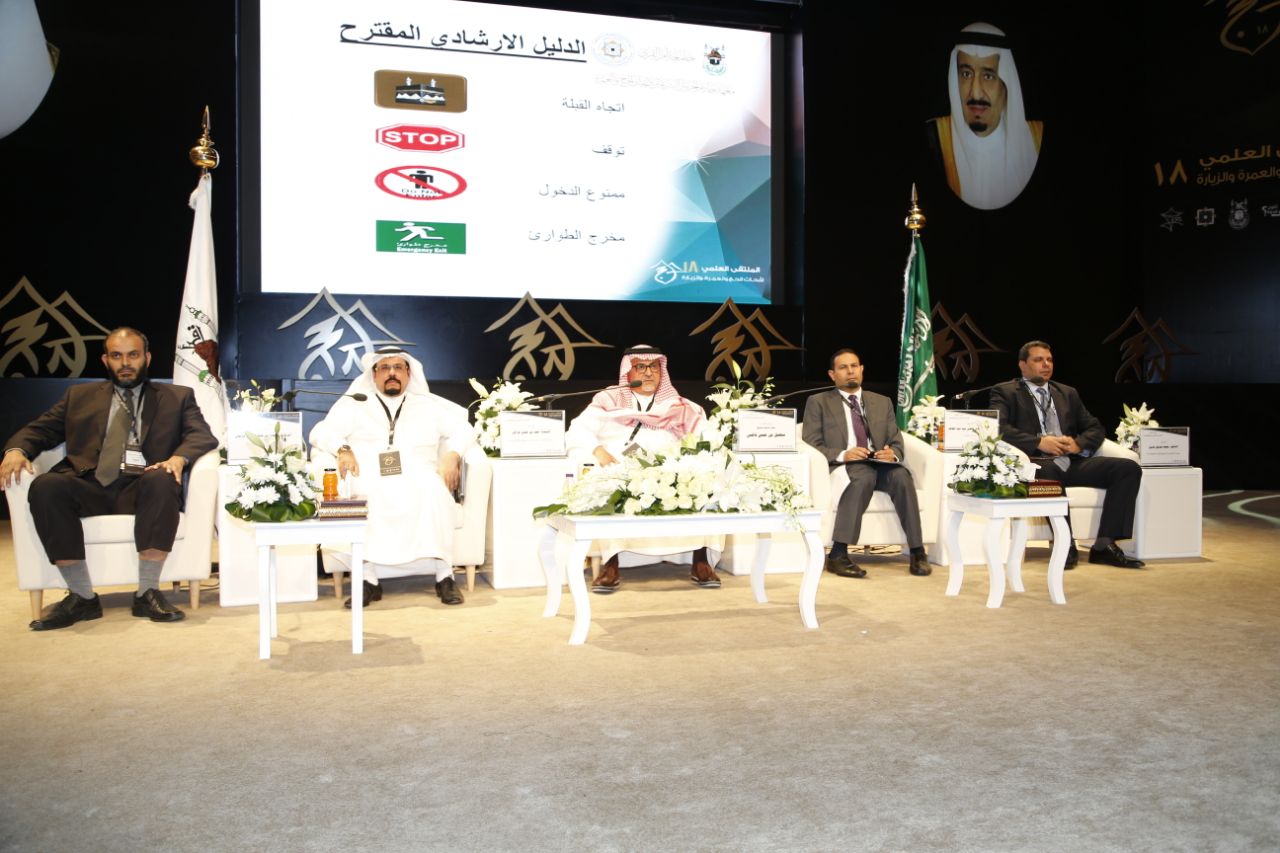
At the third scientific session headed by Dr. Suhail bin Hassan Qadi, the participants discussed "Technical and Media Studies". The researchers: Dr. Mohamed Seddik Yasin, Dr. Mahmoud Ahmed El-Jamal, and Dr. Mohamed Khaled Shambour from the Institute of the Custodian of the Two Holy Mosques for Hajj and Umrah Researches, highlighted the importance of making use of the movement of the crowds at the Holly Mosque of Madinah using modeling and simulation to find alternative ways that can contribute in regulating the crowds by obtaining accurate statistics and indicators, which could be used in evaluating the efficiency of the current systems in addition to obtaining indicators and readings to support decision makers.
In a study that measures the satisfaction of electronic track users, the researcher Omar Hassan Gazzawy, from the Prince Sultan Administration College at Al-Saisal University, stressed the importance of the electronic track and the importance of giving more room for the service offices to control its appertaining applications to facilitate the required operations quickly and accurately. He also pointed out the importance of solving the problems related to pilgrims data and searching, querying, modification, or deletion through service offices directly without a delegator..
The study displayed that when Motawifs and Hajj offices abide by applying the electronic track, the provided services shall improve to satisfy the needs of the pilgrims. Additionally, the study pointed out the importance of providing developed system for the electronic track to be suitable for the provided services by Motawifsn and offices that serve pilgrims from outside Saudi Arabia and cars syndicate.
Regarding th efficiency of electronic guiding signs in Mina that guide the pilgrims during crises, the two researchers: Dr. Iman Fathi Abdel-Mohsen at Social Science College, and Dr. Jawharah Salem Al-Kheliwy at the College of Designs at UQU; declared the study sample showed that 56% knew about the service through the guiding signs, while 31.5% knew about the services through asking about them. The research also declared that 86% chanced to encounter a guiding sign in Mina, while 59.9% showed that guiding signs are not provided for all places in Mina, and 33.4% declared that the signs do not depend on many languages. The study provided a guiding reference for the signs suggested to be used in guiding signs. In the same course, 87.5% of the sample agreed to use electronic signs that depend on solar power instead of the traditional signs.
On the other hand, the reasearchers: Ahmed Abdel-Fattah Morgan, and Dr. Khaled Mohamed Khayyat at the College of Computer and Information Systems in UQU suggested a methodology built on genetic algorithms that aim at ideal distribution of service points in sacred places, to realize the ultimate performance. This methodology can be applied in Mina, Arafat, and the Two Holly Mosques to realize the ideal distribution for some service points such as police vehicles, ambulances, fire cars, surveillance cameras, and environmental sensors, and food and drinks carts. The methodology aims at providing such services at the closest point to find such services. Two standards to measure the space were taken into consideration to implement the improvement process: the average distance and the maximum distance. the first refers to the average performance while the second refers to the worst performance. To prove the efficiency of the provided methodology, the distribution of ambulances in Arafat was studied, and the results showed that the methodology is better than the current way of distribution and the random way of distribution concerning the two standards mentioned earlier.
On the other hand, the two researchers Wagdi Helmi Abdel-Zaher and Dr. Mohamed Ali Gharib from Social Sciences College at UQU, conducted a study on the role of various communication activities in enhancing the image of Saudi Vision 2030 for the pilgrims, and identifying the most important services and programs provided by the Two Holly Mosques represented in the General Authority of the Two Holly Mosques Affairs. The study found out the 97% of the sample that encompassed 450 individuals see that the services provided by the Public Relations at the General Authority of the Two Holly Mosques Affairs help pilgrims to know the right religious rituals.
The study also showed that 90.1% see that it provides the Media with information, services, and right data for the Authority, while 80.3% see that it provides them with the dates of religious lessons held at the Two Holly Mosques. Additionally, the study showed that the most used communication ways by the individuals covered by the sample are the religious posters in the first place with 9.43% followed by the Authority magazine with 8.97, followed by social media websites with 7.97, then the brochures issued by the Authority with 7.96. Finally, the study demonstrated that 4.3% of the individuals covered by the sample are very satisfied with the communication activities at the General Authority of the Two Holly Mosques Affairs under the Saudi Vision 2030 as a source of information related to Hajj and Umra, and that 49.8% are quite satisfied, while 9.9% are not satisfied.